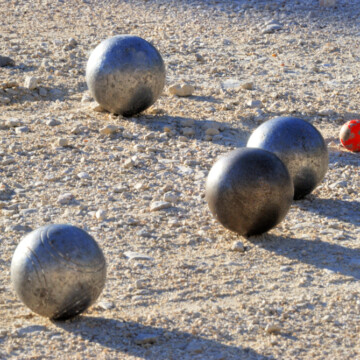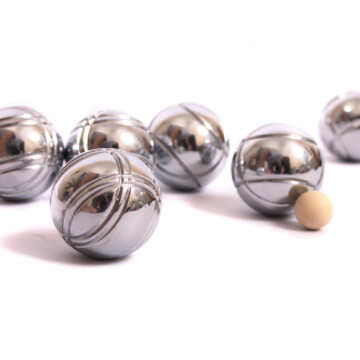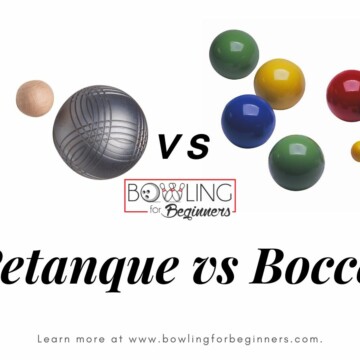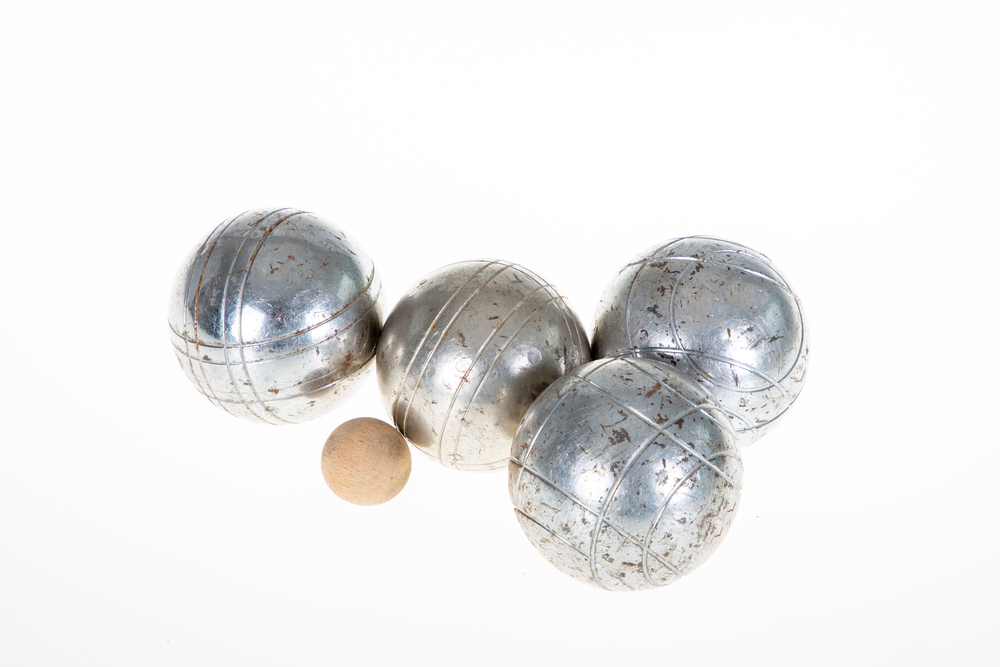
If you’re considering getting into petanque, the first thing to do is get the right equipment. And one of the most important pieces of equipment for the sport is petanque balls. But before you go out and buy yours, we urge you to read this article to the very end.
We’ll tell you everything you need to know about petanque balls so you can get your hands on the right ones. Let’s get right into it!
Contents
- 1 What Are Petanque Balls?
- 2 What Size Are the Balls in Petanque?
- 3 How Much Do Petanque Balls Weigh?
- 4 Are All Petanque Balls Hard?
- 5 Harder Boules
- 6 ½ Soft Boules
- 7 Softer Boules
- 8 Are Bocce Balls and Petanque Balls the Same?
- 9 Where to Find Petanque Balls
- 10 How Much Do Petanque Balls Cost?
- 11 What Is Petanque Called in English?
What Are Petanque Balls?
Petanque balls are balls (boules) specifically designed for throwing and/or tossing in the sport of petanque. Unlike traditional bowling balls, they are smaller, solid, and usually made of metal. You won’t find competition boules made of other materials. While leisure boules are constructed of a variety of materials, including resin.
In addition to the boules, there’s the target ball (also called the cochonnet), and this is the ball you’ll throw the metal balls (boules) toward. The goal of the game is to get your boule closer to the target ball than your opponent's boules.
If you want to repeatedly execute the elusive perfect shot, you need the right ball.
Note: There's a variation of petanque that uses cubes instead of round balls; it's called squares or square ball petanque.
What Size Are the Balls in Petanque?
| Pétanque Boule (diameter) Size in millimeters | Pétanque Boule (diameter) Size in inches |
|---|---|
| 71 mm | 2.8 inches |
| 72 mm | 2.83 inches |
| 73 mm | 2.87 inches |
| 74 mm | 2.91 inches |
| 75 mm | 2.95 inches |
| 76 mm | 2.99 inches |
| 78 mm | 3.07 inches |
| 80 mm | 3.15 inches |
According to the International and French Petanque Federations, petanque balls range from 70.5mm (2.78 inches) to 80mm (3.15 inches). The smaller petanque balls are reserved for children, and the larger ones are reserved for adults. Your petanque balls' size can have a huge effect on the game for you - if you’re not able to get a good grip on the ball because it’s too large, your tosses could be off.
And if you try to play with petanque balls that are too small, you may also see unexpected results with your tosses - too much grip isn’t a good thing.
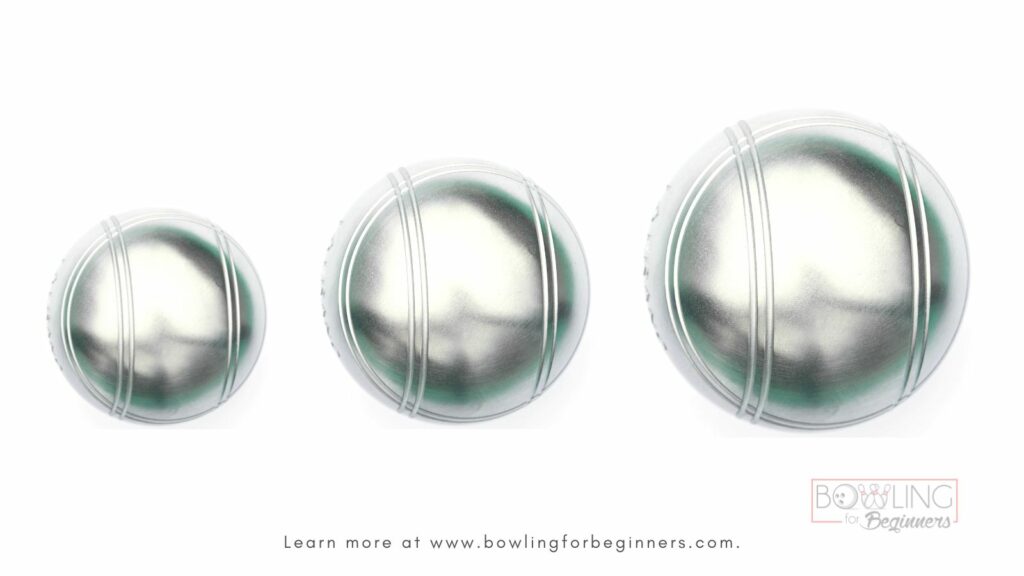
Note: There are table petanque board games that shrink the game down for indoor fun. The balls in these sets will be tiny.
How Much Do Petanque Balls Weigh?
| Petanque Boules Weight in grams | Petanque Boules Weight in pounds |
|---|---|
| 650 gr | 1.43 lbs |
| 660 gr | 1.46 lbs |
| 670 gr | 1.48 lbs |
| 680 gr | 1.50 lbs |
| 690 gr | 1.52 lbs |
| 700 gr | 1.54 lbs |
| 710 gr | 1.57 lbs |
| 720 gr | 1.59 lbs |
| 730 gr | 1.61 lbs |
| 740 gr | 1.63 lbs |
| 750 gr | 1.65 lbs |
| 760 gr | 1.68 lbs |
| 770 gr | 1.70 lbs |
| 780 gr | 1.72 lbs |
| 790 gr | 1.74 lbs |
| 800 gr | 1.76 lbs |
Petanque ball weights vary, but not by much. You’ll usually find them with a weight between 650 (22.92 oz) and 800 grams (28.22 oz). This is the same as about one pound and forty-three ounces to one pound and seventy-six ounces.
The fact that petanque balls are lightweight is great because there will be times when the kids want to get in on the fun. If the balls are too heavy, there could be an issue there. Since petanque balls come in a range of weights, you might be wondering which weight is right for you - the answer is that it depends.
Younger players may want to go with the lightest ball - closer to 650 (22.92 oz) or even less. But for adults, anywhere between 675 (1.49 pounds) and 720g (1.59 pounds) is about right. As you get further into the game and find your stride, you’ll find your ideal ball weight.
Are All Petanque Balls Hard?
Harder Boules
- More resistant /last longer
- Less expensive
- a better option for pointing
- best for hard surfaces
- Greatest bounce
½ Soft Boules
- Best of both worlds for pointer and shooter shots on all terrains
- Wear and tear is minimal
Softer Boules
- less bounce (recoil) on the playing surface
- best for the carreau shot (bumping the opponent ball away from the jack)
Yes, the shells of Petanque boules are usually hard, like those of lawn bowling and bocce - their stainless metal construction ensures that. But, going a little deeper into this topic, the hardness of petanque boules has degrees of hardness that include soft and half-soft balls. Interestingly enough, these soft and semi-soft balls may still be made of steel or other hard materials.
It’s all in how the material is treated during the manufacturing process that determines how the degrees/levels of hboule behave. Hardness has very little with how the boule feels to the touch. It has everything to do with its reaction to the terrain and its impact on and from other boules.
You might prefer harder boules as a beginner, then softer boules as you progress more in the sport, as softer balls don’t rebound as much when you hit another boule with them. This means that you may be able to execute shooting-type shots more efficiently. But if you’re just getting into this sport, it pays to keep things simple.
Go for hard petanque balls, get a feel for them, and then slowly expand your boule collection hardness as you become more skilled.
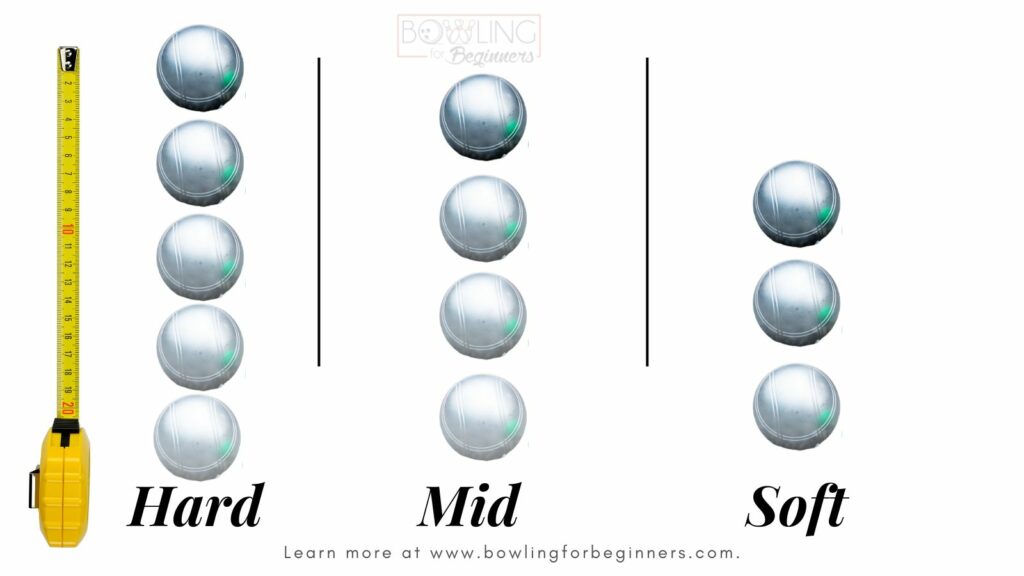
Are Bocce Balls and Petanque Balls the Same?
Bocce ball and petanque are very similar sports where a player throws or tosses larger balls toward a smaller target ball (in petanque, it’s the cochonnet, and in bocce, it’s the pallino). Still, bocce balls and petanque balls are definitely not the same. Let’s take a quick look at some of their differences:
First, bocce balls are much larger than petanque balls. In addition to that, they are made of hard plastic or composite material and can be quite colorful. What’s more, is that they are lighter than petanque balls and are constructed to be rolled on a flat surface/smooth ground or grass.
On the other hand, petanque balls are smaller, heavier, and made of metal. The reason behind this is that these balls are designed to cover sufficient distance. Petanque courts can be rougher, potentially uneven gravel or dirt (or virtually any other type of pitch).
Due to the differences between these two ball types, these two games require different strategies. This is one of the reasons why petanque and bocce are distinct games.
Note: Bocce and lawn bowling are also distinct games - read about their differences in this article.
Where to Find Petanque Balls
Finding petanque balls is not hard by any means, especially if you don’t mind shopping online. There are tons of petanque ball manufacturers currently in operation, and many of them offer their products online to be competitive.
Start online for a wide range of selections. If you’re not able to find what you need there, try eBay or do a simple Google search and browse the stores that come up.
If you’re lucky enough to live near a community where petanque is commonly played, local clubs may have recommendations on where to purchase quality balls. If not, you’ll need to call around and try several places.
How Much Do Petanque Balls Cost?
Now that you understand all there is to know about the construction and usability of petanque balls, it’s time to get into how much they cost. To begin, it’s essential to know that petanque balls will be priced differently depending on where you get them, the quality of the balls themselves, and what’s included in your petanque ball kit.
On average, you can expect to pay anywhere from $25 to over $70. The less expensive sets are going to have lower-quality balls and minimal extras; you may also find that they are extremely light. The more expensive sets will include petanque balls with quite a bit of heft and quality construction.
The right set for you will depend on what you plan on using the set for. If you’re looking to play petanque with your family and friends for a single occasion or with children, you may want to go with a more affordable set. But if petanque is a serious hobby of yours and you want to play as professional teams do, you may want to splurge a bit for your set.
What Is Petanque Called in English?
In English, petanque is often called "boules." The term "boules" refers to a family of games played with metal or wooden balls (where the objective is to throw or roll your balls as close as possible to a smaller target ball).
In reality, though, Petanque is a specific variation of boules and is one of the most popular forms of the game. It's differentiated by the stance you take as you deliver the boule (standing in a circle with your feet planted).
So, in English, you can refer to petanque as "boules" or simply as "petanque."
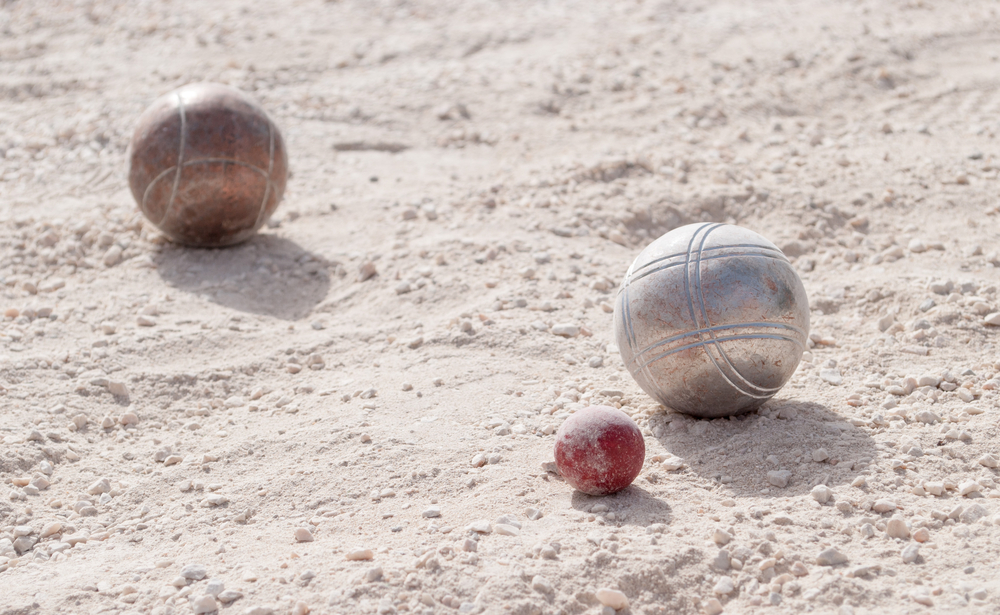
Note: Some people call petanque "French boules." This is another commonly accepted way to address the sport.
What are leisure boules?
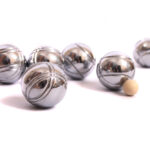
Leisure Boules: a set of 6-8 boules sold together and typically only have one size and one weight.
Competition Boules: a set of 3 boules sold together and typically have various sizes and various weights.
What's inside boules?
Fine grit and cement or nothing at all.
In this video, a boule is cleaned and cut open
What is the hardness of Petanque boules?
The hardness of boules speaks to the shell's bounce ability.
The "bounce" is your boule's impact reaction to the opponent's boule and/or the playing surface. The hardness of Petanque boules is defined by Rockwell HRC. Petanque boules have 3 general hardness: mid-soft, soft, and hard. Each level of hardness has pros and cons.
Related Articles
So, there you have everything you need to know about petanque balls. There’s more to consider than you might have thought. But if you use the tips and info in this article, you’re sure to be on the right path.
We hope you found all the information you were looking for, and we wish you the best as you have a ball playing petanque.
Kira Byrd, a Certified Fraud Examiner, holds a B.S. in Accounting from the University of Alabama at Birmingham. With a passion for bowling from her childhood, Kira has poured her expertise and personal experiences into creating and nurturing Bowling For Beginners. Kira's mission is to meet new bowlers where they are and guide them toward consistently achieving higher scores. With a focus on skill development and strategic techniques, she empowers readers to take control of their game and unlock their true potential.
Bowling For Beginners embodies strict editorial integrity, ensuring reliable and unbiased information. Kira's commitment to delivering valuable insights and practical strategies is reflected in every article. Here's an explanation of our editorial policy and how we get money.


